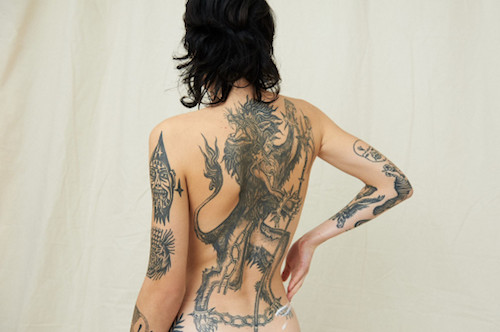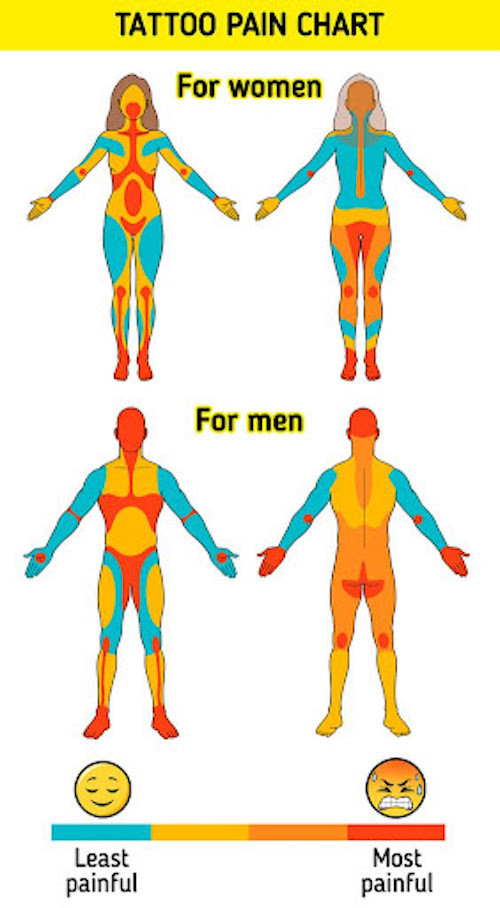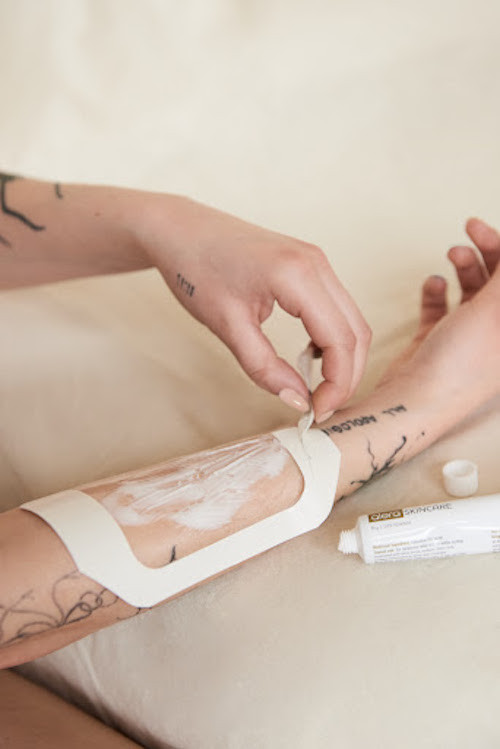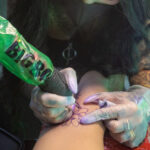Does A Tramp Stamp Tattoo Hurt? Yes, a lower back tattoo, often called a tramp stamp, can involve some discomfort, but the level of pain varies. At tattooat.com, we provide insights into tattoo pain management, the art of tattooing, aftercare tips, and the process, ensuring your tattooing experience is as comfortable as possible. Explore modern tramp stamp designs and pain relief options with us.
Table of Contents
- 1. Understanding Tramp Stamp Tattoos
- 2. The Tattoo Pain Scale: How Much Does It Hurt?
- 3. Factors Influencing Tattoo Pain
- 4. Painful Tattoo Placements: Where Does It Hurt the Most?
- 5. Least Painful Tattoo Spots: Where Does It Hurt the Least?
- 6. Tattoo Pain Chart: Female vs. Male
- 7. Minimizing Tattoo Pain: Before, During, and After
- 8. Tattoo Numbing Creams: Do They Really Work?
- 9. Tramp Stamp Tattoo Designs and Trends
- 10. Aftercare Tips for Lower Back Tattoos
- FAQ
1. Understanding Tramp Stamp Tattoos
A “tramp stamp” is a tattoo located on the lower back. Once considered a somewhat controversial trend, it has seen a resurgence in popularity, with modern designs offering a fresh take on this classic placement. The lower back is a common area for tattoos, especially among women, due to its relatively flat surface and ease of concealment.
According to Inked Magazine, the comeback of the tramp stamp is a testament to its timeless appeal and the evolving attitudes towards body art. Modern designs often incorporate intricate patterns, delicate linework, and meaningful symbols, moving away from the simpler designs of the past.
 Woman with a back tattoo
Woman with a back tattoo
2. The Tattoo Pain Scale: How Much Does It Hurt?
Tattoo pain is subjective, but a pain scale can help gauge expected discomfort. Generally, lower back tattoos rank between 4 and 6 on a scale of 1 to 10, with 1 being painless and 10 being extremely painful. However, this can vary based on individual pain tolerance and specific placement.
Factors such as skin thickness, nerve endings, and proximity to bone influence the pain level. Areas with more fat and fewer nerve endings tend to be less painful.
Understanding the Numbers
- 1-3: Minimal pain, often described as a mild scratching sensation.
- 4-6: Moderate pain, may feel like a sunburn or stinging.
- 7-9: High pain, can be intense and may require breaks.
- 10: Extreme pain, often unbearable without pain management techniques.
3. Factors Influencing Tattoo Pain
Several factors affect how painful a tattoo will be:
- Placement: Areas closer to bone or with more nerve endings are more sensitive.
- Size and Design: Larger and more intricate tattoos take longer and can cause more pain.
- Individual Pain Tolerance: Pain tolerance varies from person to person.
- Artist’s Skill: An experienced artist can minimize trauma to the skin.
- Biological Sex: Pain perception can differ between men and women.
- Skin Sensitivity: Sensitive skin may experience more discomfort.
- Stress Levels: Higher stress can amplify pain.
- Use of Numbing Cream: Topical anesthetics can reduce pain.
According to research from Portland State University’s Art Department, in July 2025, artist skill is a significant factor, providing less trauma to the skin and a more bearable experience.
4. Painful Tattoo Placements: Where Does It Hurt the Most?
Some areas are notoriously more painful for tattoos. These include:
- Rib Cage: Thin skin over bone makes this area very sensitive.
- Spine: Many nerve endings along the spine increase pain.
- Head, Face, and Neck: These areas have thin skin and numerous nerve endings.
- Hands and Feet: Bony areas with many nerve endings.
- Armpits: Delicate skin with a high concentration of nerve endings.
- Groin: Sensitive area with many nerve endings and lymph nodes.
- Knees and Elbows: Bony areas with thin skin and nerve endings.
- Collarbone and Shoulder Blade: Directly over bone with minimal fat.
| Placement | Pain Level (1-10) | Description |
|---|---|---|
| Rib Cage | 9/10 | Thin skin over bone, very sensitive. |
| Spine | 9/10 | Many nerve endings, can be excruciating. |
| Head, Face, and Neck | 8-10/10 | Thin skin, numerous nerve endings, constant movement can prolong healing. |
| Hands and Feet | 8/10 | Bony areas, many nerve endings, daily use prolongs healing. |
| Armpits | 9-10/10 | Delicate skin, high nerve concentration, close to lymph nodes. |
| Groin | 9-10/10 | Sensitive area, many nerve endings, close to lymph nodes, prolonged healing. |
| Knees and Elbows | 8-9/10 | Bony areas, thin skin, constant movement. |
| Collarbone/Shoulderblade | 9-10/10 | Directly over bone, minimal fat, pain radiates. |
5. Least Painful Tattoo Spots: Where Does It Hurt the Least?
Certain areas are less painful due to thicker skin, more muscle or fat, and fewer nerve endings:
- Outer Thigh: More fat and muscle reduce sensitivity.
- Outer Arm/Upper Bicep: Similar to the outer thigh, more cushioning.
- Forearm: Relatively thick skin and fewer nerve endings.
- Upper and Lower Back: Thicker skin and fewer nerve endings.
- Calf: Muscle mass provides cushioning.
| Placement | Pain Level (1-10) | Description |
|---|---|---|
| Outer Thigh | 4-5/10 | More fat and muscle. |
| Outer Arm | 3-4/10 | More fat or muscle, depending on fitness level. |
| Forearm | 2-3/10 | Relatively thick skin, fewer nerve endings. |
| Upper/Lower Back | 5/10 | Thicker skin, fewer nerve endings, less bony areas. |
| Calf | 6/10 | Muscle mass provides cushioning. |
6. Tattoo Pain Chart: Female vs. Male
Pain perception can differ based on biological sex. Women often report higher pain levels in the breast and stomach areas, while men may find the back, hip, and groin areas more painful.
 Tattoo Pain Chart (Female vs. Male)
Tattoo Pain Chart (Female vs. Male)
Common Pain Levels by Area
| Area | Female Pain Level (1-10) | Male Pain Level (1-10) |
|---|---|---|
| Stomach | 6-7/10 | 5-6/10 |
| Back | 4-5/10 | 5-6/10 |
| Hip | 7/10 | 8/10 |
| Groin | 8-9/10 | 9-10/10 |
| Outer Thigh | 4/10 | 5/10 |
| Outer Arm | 3/10 | 3-4/10 |
| Forearm | 2-3/10 | 2-3/10 |
| Calf | 6/10 | 6/10 |
7. Minimizing Tattoo Pain: Before, During, and After
There are several ways to minimize tattoo pain:
- Choose a Skilled Artist: Experienced artists work efficiently, reducing trauma.
- Stay Hydrated: Hydrated skin is more receptive to ink.
- Avoid Alcohol and Caffeine: These can increase sensitivity.
- Get Enough Sleep: Rest reduces stress and increases pain tolerance.
- Use Numbing Creams: Topical anesthetics can significantly reduce pain.
- Take Breaks: Don’t hesitate to ask for breaks during long sessions.
- Manage Stress: Practice relaxation techniques like deep breathing.
- Follow Aftercare Instructions: Proper care prevents complications and reduces discomfort.
Ensure you arrive at the studio with clean, exfoliated, and (potentially) shaved skin. Eat a healthful meal within 3 hours of your tattoo appointment, drink plenty of water, and avoid substances like alcohol or caffeine to keep your body hydrated.
8. Tattoo Numbing Creams: Do They Really Work?
Yes, tattoo numbing creams can be effective in reducing pain. These creams typically contain lidocaine, a local anesthetic that numbs the skin.
According to Zensa Skincare, their numbing cream contains 5% lidocaine for maximum-strength pain prevention without compromising pigment retention. The effects last for 2-3 hours and can be reapplied on broken skin.
How to Use Numbing Cream
- Apply 30-45 minutes before tattooing: This allows sufficient time for absorption.
- Seal with Saran Wrap: This increases absorption by 300-500%.
- Dab Away Excess: Remove excess cream before stenciling the tattoo.
 Tattoo Numbing Cream
Tattoo Numbing Cream
9. Tramp Stamp Tattoo Designs and Trends
Modern tramp stamp designs have evolved beyond the simple tribal patterns of the early 2000s. Current trends include:
- Floral Designs: Intricate floral patterns that extend across the lower back.
- Geometric Patterns: Symmetrical and abstract designs.
- Mandalas: Spiritual and intricate circular designs.
- Lace Patterns: Delicate and feminine designs that mimic lace.
- Nature-Inspired Designs: Incorporating elements like leaves, vines, and animals.
| Design Trend | Description |
|---|---|
| Floral Designs | Intricate flowers across the lower back, symbolizes beauty and growth. |
| Geometric Patterns | Symmetrical and abstract, represents balance and harmony. |
| Mandalas | Spiritual circular design, signifies the universe and inner peace. |
| Lace Patterns | Feminine designs mimicking lace, embodies elegance and sophistication. |
| Nature-Inspired | Elements like leaves, vines, and animals, reflect connection to nature and personal growth. |
10. Aftercare Tips for Lower Back Tattoos
Proper aftercare is crucial for healing and preventing infection. Follow these tips:
- Keep the Area Clean: Gently wash with mild soap and water.
- Apply a Thin Layer of Tattoo Balm: Use a recommended tattoo aftercare product.
- Avoid Sun Exposure: Sunlight can fade the tattoo and damage the skin.
- Wear Loose Clothing: Avoid tight clothing that can rub against the tattoo.
- Stay Hydrated: Hydration aids in healing.
- Avoid Soaking the Tattoo: No swimming, baths, or hot tubs until healed.
- Don’t Pick or Scratch: Let the skin heal naturally to prevent scarring.
Explore a wide range of tattoo designs, find talented artists, and learn more about tattoo aftercare at tattooat.com. We are committed to providing inspiration and information for tattoo enthusiasts.
Ready to explore stunning tattoo designs, find the perfect artist, and dive deep into the world of tattoos? Visit tattooat.com now and start your tattoo journey today. Contact us at Address: 1825 SW Broadway, Portland, OR 97201, United States or Phone: +1 (503) 725-3000.
FAQ
-
Does getting a tramp stamp hurt more than other tattoos?
The pain level of a tramp stamp tattoo is generally moderate, but it can vary depending on individual pain tolerance, the size and design of the tattoo, and the specific location on the lower back. Areas closer to the spine may be more sensitive. -
What can I do to prepare for my tramp stamp tattoo appointment to minimize pain?
To minimize pain, stay hydrated, avoid alcohol and caffeine, get enough sleep, and consider using a tattoo numbing cream. Ensure you eat a good meal beforehand and manage your stress levels. -
Are there any specific aftercare instructions for a tramp stamp tattoo?
Yes, keep the area clean with mild soap and water, apply a thin layer of tattoo balm, avoid sun exposure, wear loose clothing, stay hydrated, and avoid soaking the tattoo in water. -
How long does it take for a tramp stamp tattoo to heal?
A tramp stamp tattoo typically takes 2-4 weeks to heal, but it can vary depending on individual healing rates and how well aftercare instructions are followed. -
Can I use numbing cream for my tramp stamp tattoo?
Yes, tattoo numbing creams containing lidocaine can effectively reduce pain during the tattooing process. Apply the cream 30-45 minutes before your appointment, seal it with saran wrap, and dab away any excess before the artist begins. -
What are the current design trends for tramp stamp tattoos?
Current trends include floral designs, geometric patterns, mandalas, lace patterns, and nature-inspired designs, offering a modern and unique take on this classic tattoo placement. -
Is it safe to get a tramp stamp tattoo?
Yes, getting a tramp stamp tattoo is generally safe as long as you choose a reputable tattoo artist who follows strict hygiene practices and you follow proper aftercare instructions to prevent infection. -
How do I choose the right tattoo artist for my tramp stamp?
Look for an artist with experience in the style you want, check their portfolio, read reviews, and ensure they work in a clean and professional studio. A consultation can help you determine if they are the right fit. -
What should I wear to my tramp stamp tattoo appointment?
Wear loose clothing that allows easy access to your lower back and won’t rub against the tattoo during and after the session. -
Are there any health risks associated with getting a tramp stamp tattoo?
Potential risks include allergic reactions to the ink, infections, and scarring. Choosing a reputable artist and following aftercare instructions can minimize these risks.

